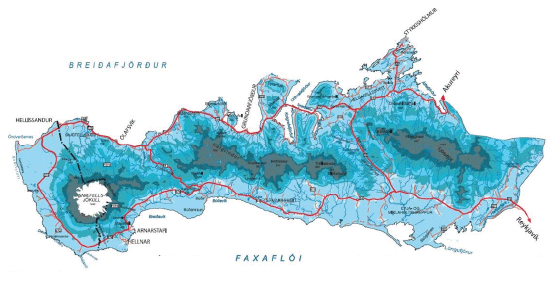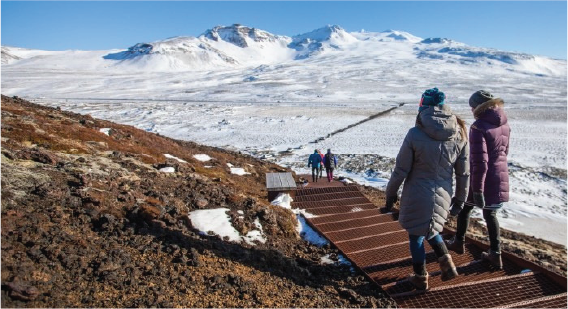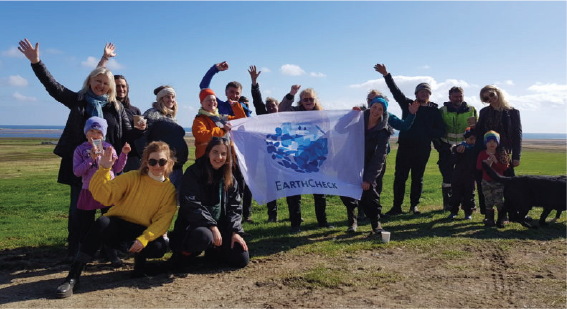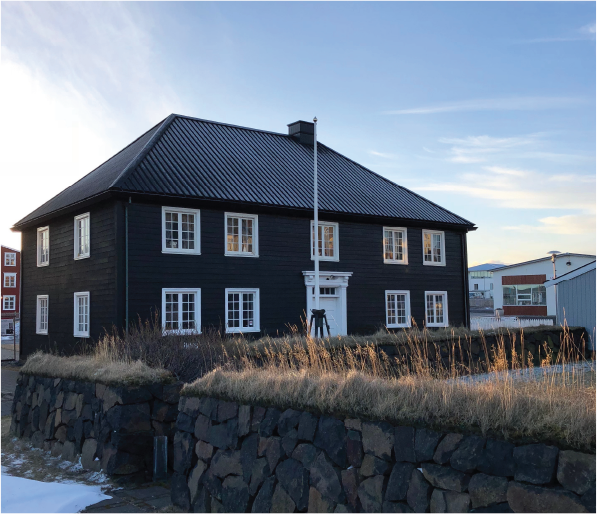-
About
-
What we do
CERTIFICATION
TRAINING
ADVISORY
Sustainable DestinationsSustainable Businesses (ESG) -
Resources
EARTHCHECK RESOURCES

Snæfellsnes is a 90 kilometre long peninsula, located in West Iceland. Recognised for its natural beauty and diversity, Snæfellsnes is a surreal combination of spectacular mountains, towering waterfalls, sandy beaches and friendly communities. The breathtaking Snæfellsjökull glacier-capped volcano is the jewel in the crown! It’s a magical place woven in history, enchantments and Icelandic sagas – the focus of Jules Verne’s science fiction novel ‘Journey to the Centre of the Earth’ and more recently a backdrop in the Game of Thrones series. Iceland has captured the imagination of many a traveller, as a mythological destination that offers deep connections and rich experiences, a holiday with lasting impact!
Snæfellsnes became the first EarthCheck Sustainable Destination in Europe and in 2018 achieved EarthCheck Platinum Certification, a milestone that marked 10 continuous years of measuring and managing their greenhouse gas emissions, energy, waste and water consumption and social impact. Determined to preserve natural and cultural assets, address local community issues and enhance wellbeing, the Snæfellsnes municipalities of Eyja- og Miklaholtshreppur, Helgafellssveit, Grundarfjarðarbær, Snæfellsbær and Stykkishólmsbær, together with the Snæfellsjökull National Park, established a shared policy of sustainable development to invest in people and training, as well as economic and social infrastructure.
Affectionately known as ‘Iceland in a nutshell’, Snæfellsnes is a traveller’s dream with breathtaking scenery and a sparse population of just 4,000 people. Life centres around fishing, agriculture and tourism, however 80% of businesses acknowledge that tourism is their main source of income and in 2018, tourists outnumbered the local Icelandic population by double. Nonetheless, the Snæfellsnes community is aware of how tourism can be detrimental if not carefully managed.

Since Snæfellsnes joined the EarthCheck Sustainable Destinations program, the local community has played a key role in their sustainability journey.
“In the beginning, we had to convince the community to be more aware and involved in our projects. Nowadays, thanks to increased global awareness and the reach of our sustainability program, more local businesses, organisations and individuals want to be involved and have started their own environmental initiatives,” – Guðrún Magnúsdóttir, Project Manager
The local workforce, community services and natural resources are a priority for the municipalities protecting cultural heritage and the individuality of each community as well as promoting job opportunities and local businesses. Working closely with stakeholders has ensured a more coordinated process and respect for laws and regulations regarding resource control.
Communication is instrumental for community engagement to enhance relationships, educate tourists, as well as reduce waste, conserve water and save energy.
An environmental initiative to reduce plastic waste in Snæfellsnes has gained momentum – reducing waste sent to landfill by almost 50%.
“Our plastic bag free community initiative took place a few years ago. It was a huge success, received media attention nationwide and sparked similar initiatives in other municipalities around Iceland.” – Guðrún Magnúsdóttir, Project Manager
In addition, the five municipalities installed either a two or three bin system for compost and recycling for homes, institutions and businesses; as well as waste stations for the disposal of light bulbs, batteries, electronics, wood and other waste materials.
Regular beach cleanup programs are coordinated to collect discarded waste from fishing activities and to minimise pollution entering the ocean. In 2019, a community coastal cleanup amassed 10 tons of waste in just one day!

The municipalities combined efforts to conserve their water resources and minimise usage of potable water.
“We’ve installed auto shut pressure on public showers and dual flush toilets and we also put regulations on the use of water in our harbours.” – Guðrún Magnúsdóttir, Project Manager
A water awareness information campaign was introduced to conserve water in homes and businesses. The use of eco-friendly certified cleaning products is encouraged and chlorine has been reduced in public swimming pools and artificial ponds.
As tourists numbers increase in Snæfellsnes, greenhouse gas emissions and energy use is measured and carefully monitored. Electric charging stations for cars have been installed across the peninsula and the community is encouraged to opt for more environmentally conscious transportation, such as walking, biking and travelling in public buses rather than driving.
The community are now using clean energy sources and have eliminated non-renewable fuels such as gasoline heating systems. The transition from electric heating to heat pumps has been beneficial, saving up to 49% of energy.

The EarthCheck Sustainable Destination program has successfully helped Snæfellsnes to measure and monitor their environmental and social impact but the path towards a more environmentally friendly community also has its challenges.
“The budget has been tight and progress has been slower in certain fields than the entities in charge of the project would have wanted. ‘It has been necessary to use the available funds sparingly and to put almost all the emphasis on the core business, at the expense of the visibility of the project for the public,” – Guðrún Magnúsdóttir, Project Manager
The EarthCheck Sustainable Destination program has helped the team at Snæfellsnes to motivate people to become more proactive and embrace sustainability. In addition, the sharing of expertise and work processes between the entities in charge, facilitated the implementation of the sustainability strategy so that resource allocation and budget expenditure is more efficient.
“It is difficult to estimate directly the value of the project – at least not yet in financial terms. Nonetheless, it is undebatable that a lot has been done for the preservation of the peninsula’s natural and cultural assets.
EarthCheck’s international reputation and credibility has played a key role in spreading the word about the project and getting people on board”
“We care greatly about our natural resources and wildlife, and we’re working on future projects to keep our environment clean. Looking back at what we have achieved, we can see that we have come a long way. Our goal is to improve further – successful work takes time so we will continue, step by step. There is hope for sustainability; it’s the only option we have.” – Guðrún Magnúsdóttir, Project Manager

There are more than 476 million Indigenous Peoples, found in all regions of the world, from the Arctic to the tropical forests. They make up more than 6 per cent of our global population.
In the spirit of reconciliation, EarthCheck acknowledge the Traditional Custodians of Country throughout the world and their connections to land, sea and community. We pay our respect to their Elders past and present and extend that respect to all Indigenous Peoples today.
EarthCheck acknowledges that Indigenous Peoples are guardians of the forests and biodiversity hotspots we all depend on. Research shows that lands managed by Indigenous Peoples, with secure rights, experience lower deforestation rates, store more carbon, hold more biodiversity, and benefit more people than other lands — including protected areas.
We recognise and support the United Nations Declaration on the Rights of Indigenous Peoples (UNDRIP), the most comprehensive international instrument on the rights of Indigenous Peoples. The Declaration is a positive document that maps out a path for Indigenous Peoples to be free from discrimination and secure in their identities and life choices.
EarthCheck science and products were developed by the Australian Government Sustainable Tourism Co-operative Research Centre (STCRC) over ten years. Our science is reviewed annually to ensure that it meets international standards relative to greenhouse gas protocols, responsible tourism, and certification.
EarthCheck products and services are built on the Agenda 21 principles for Sustainable Development endorsed by 182 Heads of State at the United Nations Rio De Janeiro Earth Summit in 1992 and aligned to the SDGs.
EarthCheck Certified provides a framework for organisations to achieve the desired outcomes for sustainable development as set out in the final report of the World Summit for Sustainable Development held in Johannesburg in 2002.
EarthCheck Certified complies with the Mohonk Agreement (2000), which outlines the guidelines and principles for an international sustainable tourism certification program. It is also a Recognised program of the Global Sustainable Tourism Council (GSTC).
EarthCheck Certified is a verification standard accepted by CDP. It is also an approved program of the Certification and Accreditation Administration of the People’s Republic of China (CNCA), London & Partners, the Mexican Secretary of Tourism (SECTUR) and the City of Sydney.
EarthCheck Certified is an approved program for meeting the EU Energy Directive for the Federal Office for Economic Affairs and Export Control (Bundesamt für Wirtschaft und Ausfuhrkontrolle – BAFA) in Germany and the Netherlands Enterprise Agency (Ministry of Economic Affairs and Climate Policy) in the Netherlands.
EarthCheck partners with international research organisations to maintain the currency of EarthCheck science and our benchmarking systems.
The EarthCheck brand signifies scientific excellence, better environmental, economic, and social performance, improved community interactions, and savings through more efficient use of resources. It provides recognition and promotional support to a global consumer market.